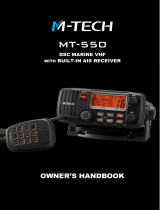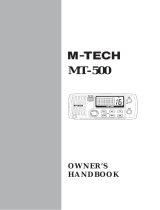
5
Do not place the transceiver on an unsteady or
sloping surface, or in a location with extreme
vibration.
The transceiver may fall or drop, resulting in fire,
injury and equipment damage.
Stay as far away from the antenna as possible
during transmission.
Long-term exposure to electromagnetic radiation
may have a negative effect on the human body.
Do not wipe the case using thinner and ben-
zene etc.
Use only a soft, dry cloth to wipe stains from the
case.
Keep this product out of the reach of children.
Injury to the child, or damage to the transceiver
may result.
Do not put heavy objects on top of the power
cord and connection cables.
This may damage the power cord and connection
cables, resulting in fire and electric shock.
Do not use any products other than the speci-
fied options and accessories.
Failure or miss operation may result.
For safety reasons, switch off the power and
pull out the DC power cord connected to the DC
power connector when the device is not going
to be used for a long period of time.
If not, this may result in fire and overheating.
Do not throw the transceiver, or subject it to
strong impact forces.
Physical abuse may result in component damage
and equipment failure.
Keep magnetic cards and videotapes away
from the transceiver.
The data recorded on cash cards or videotapes
may be erased.
Do not stand on top of the product, and do not
place heavy objects on top or insert objects in
-
side it.
If not, this may result in equipment failure.
CAUTION
WARNING
Do not power this transceiver with a voltage
other than the specified power supply voltage.
A fire, electric shock, or damage may result.
Do not make very long transmissions.
The main body of the transceiver may overheat,
resulting component failure or operator burns.
Do not disassemble or make any alteration to
this product.
An injury, electric shock, or failure may result.
Never touch the antenna during transmission.
This may result in injury, electric shock and equip-
ment failure.
Do not handle the power plug and connector
etc. with wet hands. Also do not plug and un
-
plug the power plug with wet hands.
This may result in injury, liquid leak, electric shock
and equipment failure.
Disconnect the power cord and connection ca-
bles before incorporating items sold separately
or replacing the fuse.
This may result in fire, electric shock and equip-
ment failure.
When smoke or strange odors are emitted from
the radio, turn off the power and disconnect the
power cord from the socket.
This may result in fire, liquid leak, overheating,
damage, ignition and equipment failure. Please
contact our company customer support or the retail
store where you purchased the device.
Keep the power plug pins and the surrounding
areas clean at all time.
This may result in fire, liquid leak, overheating,
breakage, ignition etc.
Never cut the fuse holder off of the DC power
cord.
This may cause a short circuit and result in igni-
tion and fire.
Use only the specified type fuses.
Use of an incorrect fuse may result in fire and
equipment failure.
When connecting a DC power cord, be certain the
positive and negative polarities are correct.
Reverse connection will result in equipment damage.
Do not use DC power cords other than the one
enclosed or specified.
This may result in fire, electric shock and equip-
ment malfunctions.
Do not bend, twist, pull, heat and modify the
power cord and connection cables in an unrea
-
sonable manner.
This may cut or damage the cables and result in
fire, electric shock and equipment failure.
Do not pull the cable when plugging and un-
plugging the power cord and connection ca-
bles.
Always hold the plug or connector when unplug-
ging; if not, a fire, electric shock and equipment
failure may result.
Do not use the device when the power cord
and connection cables are damaged, or when
the DC power connector cannot be plugged in
tightly.
Contact Yaesu Amateur Customer Support or the
retail store where this transceiver was purchased
for assistance, as this may result in fire, electric
shock and equipment failure.
Follow the instructions provided when installing
items sold separately and replacing the fuse.
This may result in fire, electric shock and equip-
ment failure.
Use only the provided or specified screws.
Using screws of a different size, may result in fire,
electric shock and component damage.





















